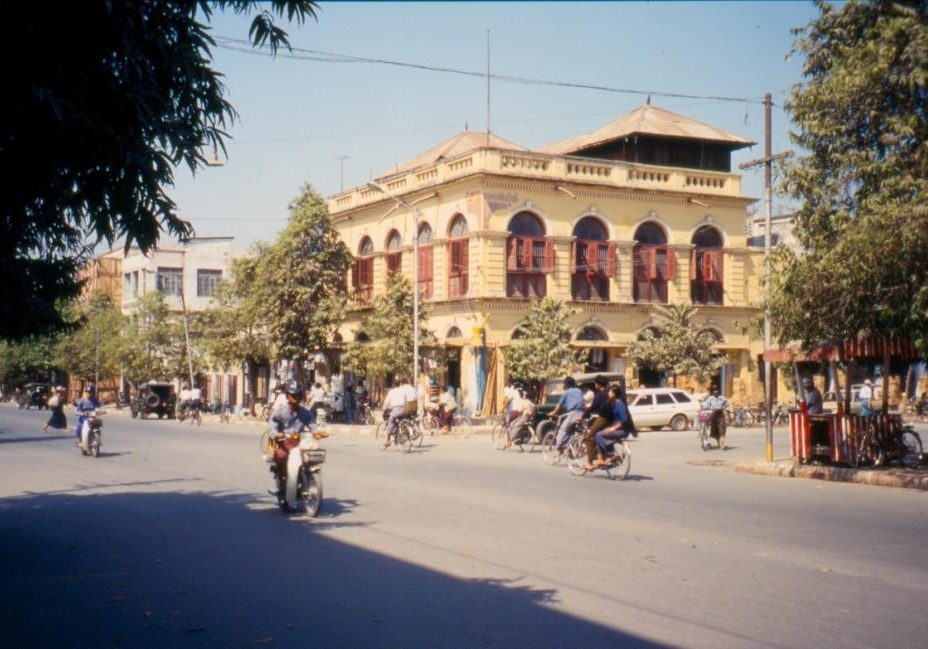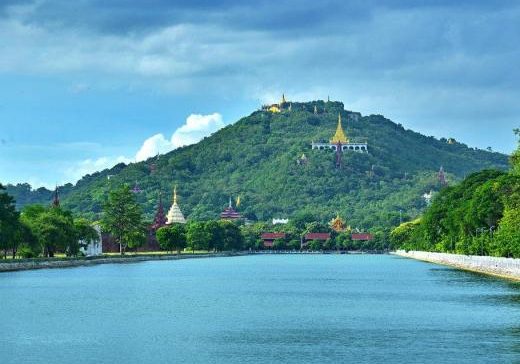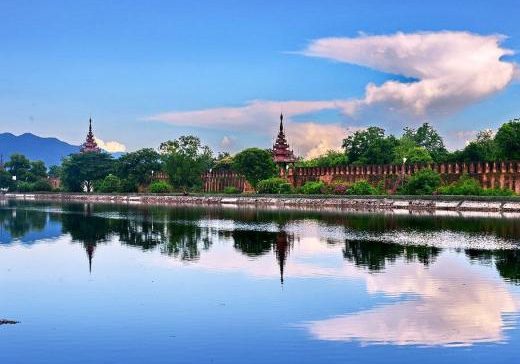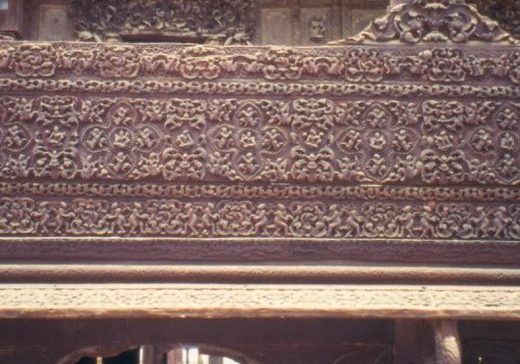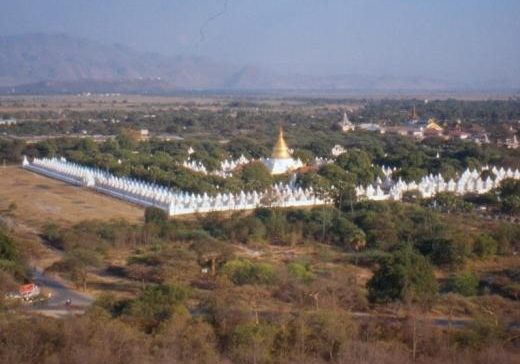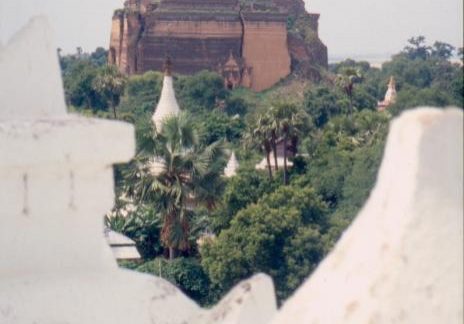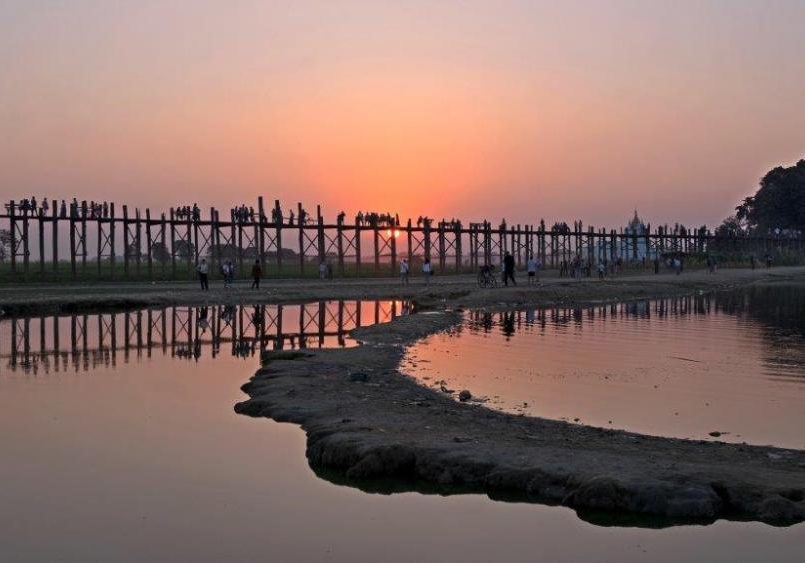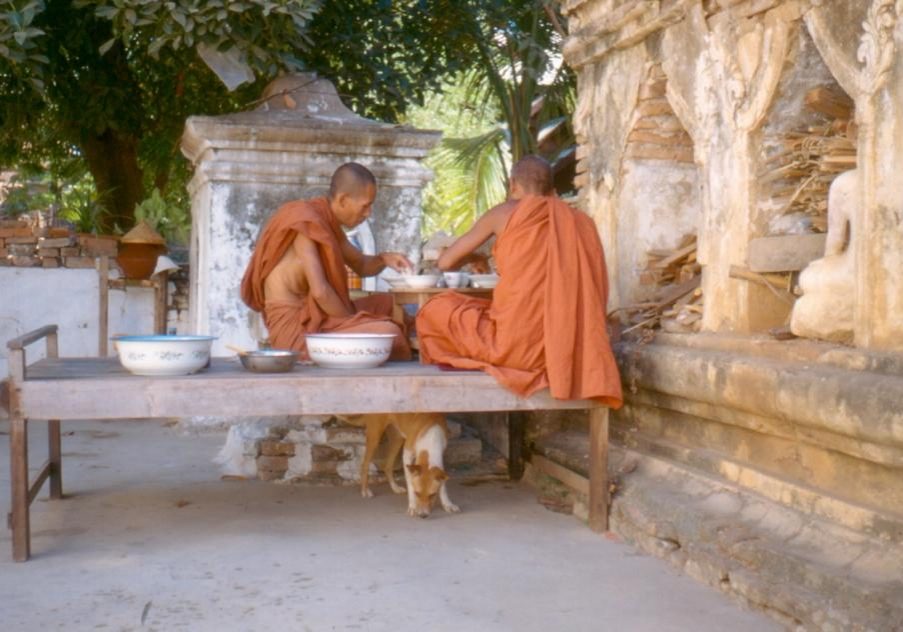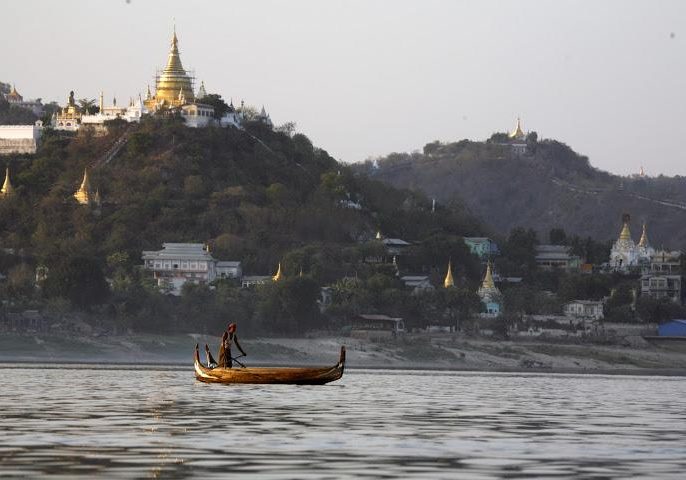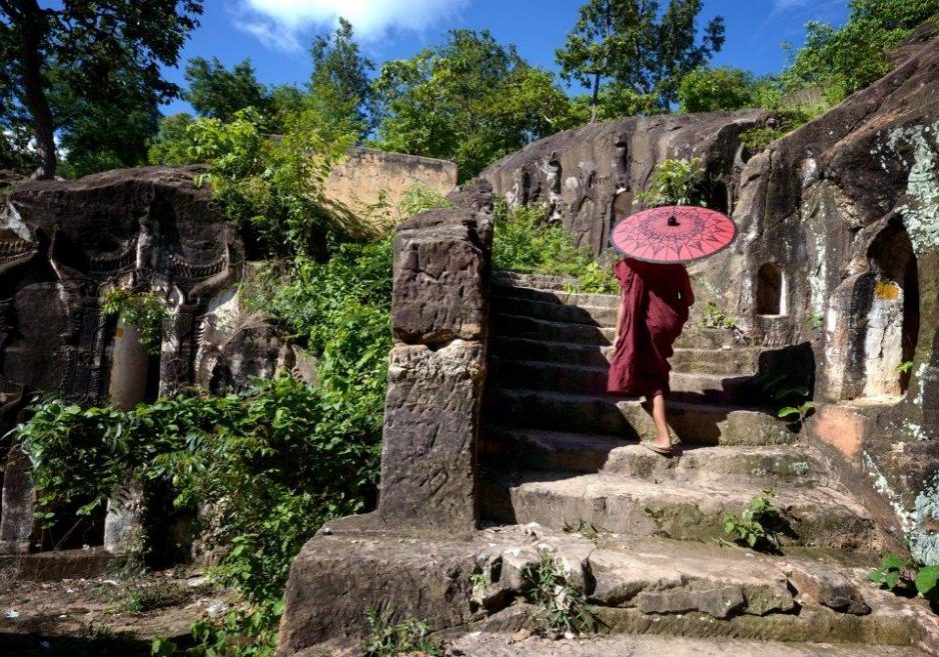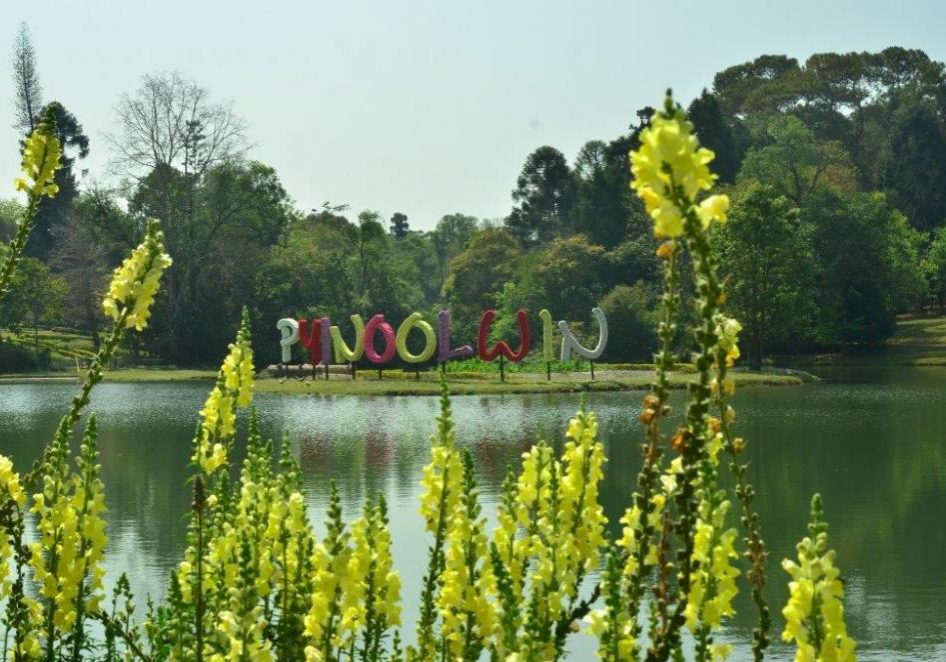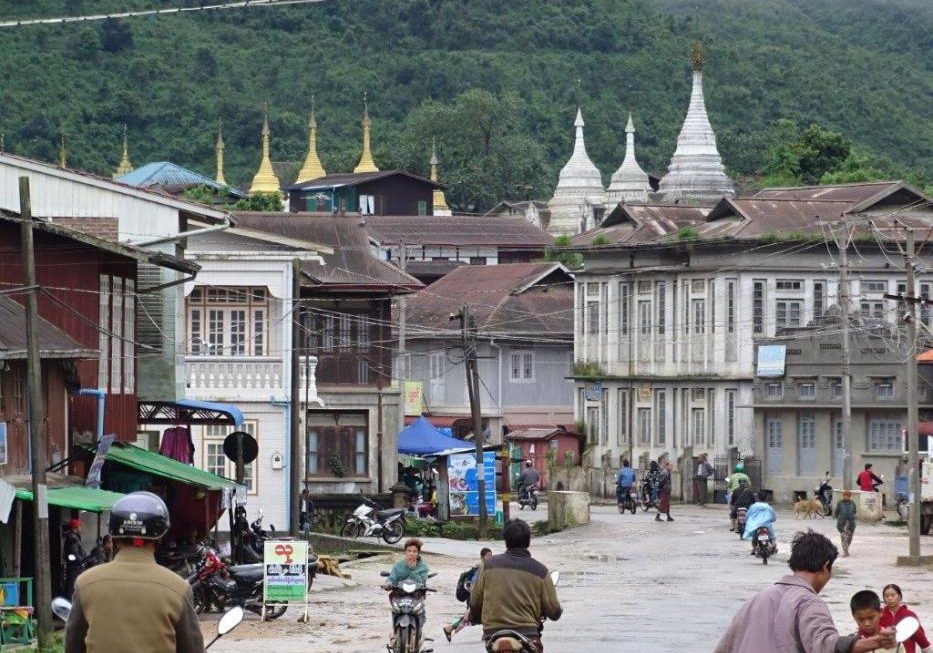The capital of Myanmar Last Kingdom and of Myanmar Kings, is situated in Central Myanmar 668 km north of Yangon. It was founded by King Mindon in 1857 and remained to be the official seat of Myanmar Kings until it was occupied by the British in 1885 and designated Yangon as capital. It is the largest city after Yangon and is both a bustling commercial center and a repository of rich cultural heritage. With the remains of the old Royal City and many old monasteries, Mandalay is a showcase for Myanmar art and architecture of the 19th century. It is also noted for woodcarvings, silverware, tapestries, silk, and other products of traditional handicraft. It has links to all parts of the country by rail, road, river and air.
Places of interest
DOWNTOWN
Mandalay itself is a dirty, dusty town with some areas that have changed little in nearly a century, but it oozes with photographic opportunities and has its own special charm. Take a walk along the riverside early morning or late afternoon to watch the busy riverside activity and to see the water buffalo working hard to bring newly felled logs to the shore or spend a couple of hours wandering around the sprawling Zegyo Market, originally designed by an Italian architect in 1903. The Zegyo Market is the center of trade linking between towns of upper and lower Myanmar. Various local and imported (mainly from China and Thailand) goods are in business. The Italian-styled old market building was demolished and replaced with modern form. The Clock Tower, next to the Zegyo Market, was built in 1903 to commemorate the diamond jubilee of Queen Victoria.
MANDALAY HILL
The natural landmark of Mandalay, a vantage-point for panoramic view of the city. The stairways are being constructed from the bottom to top of the hill which you can climb at ease and rest as you go up the stairway. There is a saying that if you want to live long, you take refuge in the environs of Mandalay hill. It means that as climbing to the Mandalay hill on foot is good for health. And to pay homage to the pagoda along the way makes one live long. You can pay homage to prominent pagodas along the stairway of Mandalay Hill. Besides, you can visit the shops of Myanmar traditional handmade toys, gifts such as beads.
MANDALAY PALACE
The whole magnificent palace complex was destroyed by fire during the World War II. However, the finely built palace walls, the city gates with their crowning wooden pavilions and the surrounding moat still present an impressive scene of the Mandalay Palace. A number of palace buildings namely "Mya-nan-san-kyaw Shwenandaw", the model of the Mandalay Palace, Nanmyint-saung have been rebuilt and the Cultural Museum is also located inside the palace grounds.
SHWENANDAW MONASTERY
Famous for its intricate wood-carvings, this monastery is a fragile reminder of the old Mandalay Palace. It was originally built inside the Mandalay Palace but it was moved to the present site by King Thibaw in 1880.
KUTHODAW PAGODA
Built by King Mindon in 1857, modeling on the Shwe Zigon at Nyaung U, this pagoda is surrounded by 729 upright stone slabs on which are inscribed the entire Buddhist Scriptures as edited and approved by the 5th Buddhist Synod. It is popularly known as "the Worlds Biggest Book" for its stone scriptures.
ATUMASHI KYAUNG
The Atumashi Kyaung, or Incomparable Monastery was originally built in 1857 by King Mindon (1853-1879) and burned down in 1890. For many years the ruins of the building lay open to the elements. Stumps of the charred teak pillars, a grand staircase and some colonnaded walls remained. The area was cleared in the 1990s and was rebuilt according to the original plans in 1996 by the Burmese archaeological department with the use of convict labor. While somewhat impressive, it does not come close to recreating the magnificence of the original building. The Atumashi Kyaung is near the Kuthodaw Pagoda, built at the same time, and next door to the Shwenandaw.
KYAUKTAWGYI PAGODA
Near the southern approach to Mandalay Hill stands the Kyauktawgyi Pagoda of the Buddha Image that was built by King Mindon in 1865. The Image was carved out of a huge single block of marble and sculpted. It was hauled to its position by nearly 12,000 men and took 13 days to transport the marble. The statues of 80 Arahants (the Great Disciples of the Buddha) are around the Image, 20 on each direction.
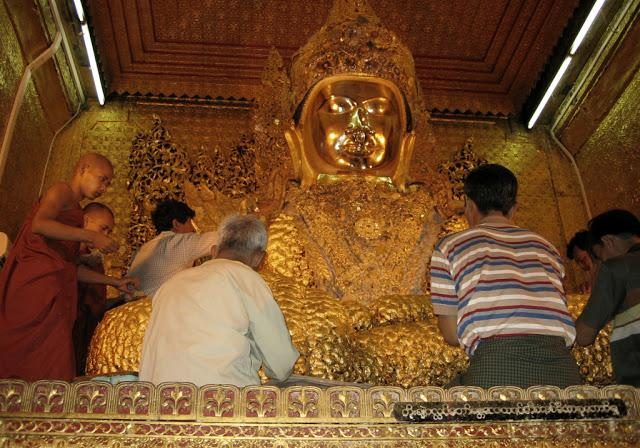
MAHA MUNI PAGODA
Revered as the holiest pagoda in Mandalay, this pagoda enshrines the famous Maha Muni Buddha image, which is said to have been cast in the life-time of and in the very presence of the Buddha. Consequently, devout Buddhists hold it to be alive and refer to it as the Maha Muni Sacred Living Image. The Image in sitting posture is 12 feet and 7 inches (3.8 meters) high. It was brought to Mandalay from Rakhine State during the reign of King Bodawpaya in 1784. The early morning ritual of washing the Face of the Buddha Image draws a large crowd of devotees everyday. And the image is also considered as the greatest, next to Shwedagon Pagoda, in Myanmar. A visit to Mandalay would be incomplete without a visit to Maha Muni Pagoda.
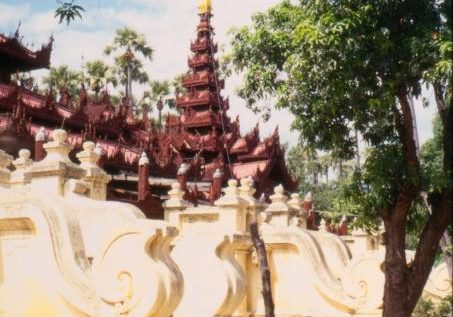
SHWE IN BIN MONASTERY
This attractive monastery built in traditional Burmese fashion is one of the few buildings that have survived the test of time. Constructed in 1895 by Chinese merchants, the monastery consists of many impressive woodcarvings and also contains a number of admirable works of art. At present there are 35 monks that live in the monastery complex which is held up by the classical teak foundation that is often seen throughout the country but rarely in as good condition as at this illuminating site.
YANKIN HILL
3 km east of Mandalay Fort has a whole complex of temples and monasteries running along the top of its ridge. With two staircases at either 'end' of the hill, you can walk the complete circuit - so take your shoes with you.
ARTS AND CRAFTS
For lovers of arts and crafts, Mandalay represents the largest repository of Myanmar arts and crafts. It is here that visitors can observe skilled craftsmen making beautiful articles of tapestry, ivory, wood, marble and stone carving and engravings, silverware and bronze statues according to the time-honored traditions of their forefathers. Besides those, the other arts and crafts workshops of silk-weaving and gold-leaf making are also places worthy of visiting.
Other places of interest near Mandalay
MINGUN
Located about 11 km upriver from Mandalay, on the west bank of the Ayeyawaddy River. The one hour boat trip to Mingun is a very pleasant way to see the real life on the river. Mingun has a gigantic unfinished pagoda, 50 meters high, overlooking the river, and the 90-ton Mingun Bell, the largest ringing bell in the world cast in 1170 by King Bodawpaya.
AMARAPURA
Amarapura the "City of Immortals", situated about 11 km south of Mandalay, was the capital of upper Burma until 1850. As it was the custom, most of the important wooden palaces and monasteries were taken down and transported to the new capital in Mandalay. Little remains of the old Amarapura palace but you can still find two masonry buildings - the treasury building and the old watchtower. The corner pagodas still stand at the four corners of the once square city. Apart from Pagodas that have survived, the ancient art of silk and cotton weaving, using handlooms is very much alive. The 150 year old Mahagandayon Monastery, is a famous Buddhist learning center and home to a thousand monks, who will form a procession as they go to take their noon and final meal of the day and the 1.200 meter long U Bein wooden bridge, over 150 years old, is the longest teak bridge in the world.
IN-WA (AVA)
Ava situated on a small island, between the Ayeyarwaddy and Myittha rivers, was first founded as a capital by King Thado Minbya in 1364 A.D. It was destroyed by the earthquake of 1838. The ruins of the palace, the massive fort walls and moat can still be seen of the splendour of the past when it had been the capital for more than four and half centuries. The best way to explore this island is by horse cart. The king palace at that time does not exist any longer, however still the “Leaning Tower” of Inwa, 27 meter (90 feet) high masonry Watch Tower. The Maha Aung Mye Bon Zan Monastery, a brick-and-stucco monastery built by the Chief Queen of King Bagyidaw for her royal abbot (Nyaung Gan Sayadaw) in 1818 and the Bagayar Monastery, famous for its impressive ornate woodcarvings and teak posts are the high lights.
SAGAING
Sagaing lies 21 km southwest of Mandalay on the opposite bank of the Ayeyarwaddy River. Once you cross the Inwa Bridge, you see the hilltops, each crested with a pagoda, the banners proclaiming the Buddha's teaching, the refuge from all ills and tribulations where over 600 monasteries for monks and nuns are located for Buddhist studies and meditation. The Padamyazedi dates from 1300 while the U min Thonze or thirty caves pagoda has many Buddha images in a crescent shaped colonnade. Mural paintings can be seen in the Tilawkaguru cave temple, which was built around 1672. At the nearby village of Ywahtaung you can see silver workers producing bowls and other silver items by traditional methods. The most impressive Soon Oo Pon Nya Shin Pagoda nearby was constructed in 1312. The view of Sagaing from Soon Oo Pon Nya Shin and its approach is marvelous. About 10 km from Sagaing is the Kaunghmudaw, an enormous dome-shaped pagoda built by King Thalun in 1636, on the model of the Mahaceti Pagoda of Sri Lanka. At the nearby village of Ywataung, you can see silversmiths making silverware by traditional methods.
MONYWA & PHO WIN DAUNG
About 136 km to the west of Mandalay lies Monywa, the commercial center of the Chindwin Valley or northwestern Myanmar. Places of interest include Thanbokde Pagoda, with over 500,000 Buddha images; Bodhi-ta-taung (one thousand Bo trees): Ledi Kyaungtaik, a teaching monastery where Buddhist scriptures are inscribed on 806 stone slabs: and Kyaukka Village, known for its own distinctive style of lacquerware. Just on the other side of the Chindwin River and a 30 minutes drive by pick-up is the seldom visited 15th Phowin Taung temple complex where more than 450,000 sandstone Buddha’s were carved in the hillsides in caves, alcoves, or tiny niches. The cave murals are still intact with indigo blues and soft pastels. Many of the Buddha’s can be seen without entering the caves or niches and footwear is permitted as long as one is not entering the sanctuaries. A stunning Buddha not to be missed is the reclining Buddha resting on a rectangular stone mosaic which shimmers with cut glass."
SHWEBO
Shwebo is a rice-collecting centre on the railway about 50 miles (80 km) north-northwest of Mandalay and 17 miles west of Kyauk Myaung, a river-side town on the Ayeyarwady, which is famous for glazed pottery works from toys, cups, letters, bowls, pots to huge water jars that are tied in hundreds and floated down the river as rafts. These are widely used throughout the country. Shwebo was the birthplace of Alaungpaya, founder of the Alaungpaya dynasty (1752–1885), and is the site of his tomb. The palace and other royal parks, lakes, moats and watch tower have been neglected, disrepaired, ravaged and ruined in the last two centuries. With the promotion of the tourism industry, the government has launched upon the reconstruction of the palace buildings, parks and dredged the royal lake for the benefit of the visitors and locals.
PYIN-OO-LWIN (MAYMYO)
Over 1000 meters above sea-level, Pyin Oo Lwin is a popular hill station about 69km away from Mandalay. It is well known for its colonial style houses with large compound and pine trees, eucalyptus and silver-oak abound in town. Delightfully cool and pleasant the whole year round. It was founded by Myanmar official Maung Dwe in 1851 and later named as May Myo by British Colonel May in 1896. The 142-hecter well laid-out Botanical Garden, scenic Pwe-kauk Waterfalls, Chinese Temple in addition to British built colonial buildings are places worth visiting. Nearby are Peik-chin-hmyaung Cave and Gokteik Rail Bridge.
PALEIK
You can find many wondrous places in various part of the world and Myanmar is no exception. One of these is the Snake Pagoda, situated at the town of Paleik, which is 15 miles from Mandalay.
The formal name of the Pagoda is known as “Ratana Laba Muni Sutaungpyi Muei Phaya” but it is known to be as “Meui Phaya” or “Snake Pagoda”. In 1977, a Buddhist monk was clearing the bush in that area and found a Buddha image inside a ruined Pagoda.
On top of the image were three large pythons and from that time on, the place became known far and wide in the country as the Snake Pagoda. Each snake is fed a pot of milk and three eggs every five days. But later on, due to instructions from a veterinarian, each was given 50 ticals of goat meat for protein. But every morning at 11:00 a.m., the snakes are given a bath. Pilgrims from various parts of the country come to pay homage to the snake Pagoda in Paleik town whenever they arrive in Mandalay. It is Buddhist belief that even animals through merit earned in previous existences are deserving of care and attention.
MOGOK
More mysterious than Mecca and more difficult to reach than Lhasa. That is how Joseph Kessel describes it in his novel. In the heart of the mountains, located some 200 kilometres north-east of Myanmar’s second largest city, Mandalay, the valley of Mogok has been producing the most beautiful rubies and the most unusual legends for over a thousand years.
Yet Mogok has much more to offer than just precious stones. Little towns, villages and gardens are dotted here and there across the hills, which are covered with shrubs and flowers and decorated with well-kept Buddhist shrines. The tips of the gold leaf-covered pagodas stretch towards the sky like golden sculptures jutting out of rock formations and line the only main road in the region, as well as gravel roads and footpaths.
Restaurants in Mandalay
Street Food at Zegyo Market
While Mandalay’s cafes and restaurants proffer an array globe-spanning cuisines and offer a glimpse into local life, the city’s true culinary heart still exists in its street food, often centered on its markets. Zegyo Market is both the largest and oldest in Mandalay. Though now housed in an uninspiring shopping center, you can browse all manner of delights in the scores of colorful, canopied stalls that surround it. If you don’t feel like sampling chicken gizzards, pig’s stomach or curried lungs, try mohinga, a fish noodle soup that has long been Myanmar’s unofficial national dish. For something a little sweeter, pick up some kauknyintok, steamed bananas wrapped in coconut leaves.
Address: Corner of 84th St. and 26th St.
Aye Myit Tar Restaurant
Close to the Mahamuni Pagoda, Aye Myit Tar is a favorite with locals and tourists alike. Set in an unpretentious room covered with photographs of Myanmar, the staff are extraordinarily friendly and eager to sit you at their tables. The most popular choice here is the Myanmar curry, which holds Indian and Chinese flavor’s in a delicate balance and comes with a smattering of complimentary vegetables, salad and broth. More adventurous diners should try the meeshay, rice noodles cooked in a clay pot with a thick, oily meat sauce.
Opening hours: 09:00 – 22:00
Address: No (530), 81th Street, between 36th x37th street, Mandalay
Tel.: 31627
Lashio Lay
The best Shan food in Mandalay. It’s a very simple place used by locals: Formica tables, stools to sit on, and scruffy round the edges. The food is arranged in canteen-style trays: a selection of curries, noodles, salads and stir-fried vegetables. Do try the fish steamed in a banana leaf and the fresh tofu curry. Some dishes are fiery so watch out. Arrive by 1pm for lunch and 7pm for dinner when the food is freshly cooked. The place can take some finding so ask your hotel to write the name and address down in Burmese for the taxi driver.
Opening hours: 06:00 – 22:30
Address: No (65), 23rd Street, between 83rd & 84th Street
Tel.: 38568.
Super 81
With southern Chinese immigrants accounting for over a third of the city’s population, it’s no surprise that many of Mandalay’s best eateries specialize in Cantonese and Yunnan food. Super 81 stands out in a crowded field, serving up a huge variety of dishes; there are a dozen variations of steamed duck alone, along with excellent squid and sea bass, all served in generous portions. Its labyrinthine layout only adds to the charm, with a sprawling network of rooms, terraces and roof gardens hidden behind an unassuming shop front.
Opening hours: 09:00 – 23:00
Address: No. (582), 81st Street, between 38th and 39th Street
Tel.: 32232
Marie Min Vegetarian Restaurant
From 1885 to 1948, while subjected to the British Empire, Myanmar’s colonial rulers saw it as a vital connection between India and Singapore. As a major stopping point on the trade route, Mandalay has long been influenced by its northern neighbors, and is today dotted with numerous authentic Indian eateries. Marie Min, located down an alleyway a block to the south of the Palace, is particularly admirable. Everything on the menu is vegetarian, including the breakfast buffet frequented by Western backpackers. Come in the evening for diverse menu of delicious curries, accompanied with dahl, baingan bharta (roasted aubergine sauce) and a range of lassis.
Opening hours: 09:00 – 22:00
Address: 27th Street, between 74th and 75th Street
Tel.: 36234
Mobile: 0943197231
Yunnan III Restaurant
One of the most delightful side effects of Mandalay’s flourishing migrant population has been the emergence of the southern Chinese barbeque. Set around a voluminous outdoor seating area, Yunnan III epitomizes this trend while harking back to the traditional teahouse. Curate your dish from a lavish selection of meat, vegetables and noodles then watch as they are freshly grilled. Often filled with groups of local men drinking whisky, smoking cigars and watching football, it’s one of the best places in Mandalay for meeting friendly residents and imbibing a sense of community.
Opening hours: 10:00 – 23:00
Address: 62nd Street, between 36th and 37th Street
Mobile: 0991004431
Unique Myanmar
This welcoming, open-sided restaurant opened a year ago and has already captured a lot of business from its more touristy neighbors. There’s a good choice of meat and vegetarian options. Do try the fresh fruit juices and the smoky grilled aubergine and the shredded ginger salads. The staff have all been recruited from same village near Bagan, brought here and trained by the family that owns the place. They do a great job.
Opening hours: 11:00-23:00
Address: Corner of 27th x 65th Street
Tel.: 23562
Mya Nandar Restaurant
The Mya Nandar is the only restaurant on the riverfront in Mandalay. It occupies a large teak pavilion beside the Ayeyarwady River. Tables are set up both inside around the stage used for the evening cultural performances (from October to March, 7.30pm to 9pm) and outside beneath tamarind trees overlooking the river. I prefer to have to lunch here watching the river craft, from overloaded riverboats to fishermen in their wooden skiffs. Slap on plenty of mosquito repellent at dusk and ask for a coil to be lit beneath your table.
Opening hours: 11:00 - 23:00
Address: 26th x 35th Street, Strand Road, MyoTaw Garden West
Tel.: 66110
Mobile: 0991013473
Green Elephant
Green Elephant is the most luxurious place in Mandalay for a traditional culinary experience. Part of a small chain with three branches throughout the country, it began in a disused Yangon garage with the aim of fusing Myanmar food with Western standards of service and cleanliness. Set within an early 20th century colonial villa with a bucolic garden, it’s something of an oasis removed from the dust of the surrounding streets. Authentic Burmese dishes include tealeaf salads, fine curries accompanied by soy paste and moet-hin-kar fish soup. Thai and Chinese menus are also available, and all the food uses vegetables from the restaurant’s own local garden.
Opening hours: 11:00 – 21:30
Address: No. (3/H), Block 801, 27th Street, between 64th and 65th Street
Tel.: 61237 / 74273
Mobile: 092038207
A Little Bit of Mandalay
For those who wish to try Myanmar traditional cuisines, but do not prefer strong tasting, oily, salty and spicy fare, A Little Bit of Mandalay is a good choice. Situated in the tranquil eastern part of the city, the decade-old restaurant is serving the Burmese traditional cuisines such as Thee Sone Hnat (vegetable curry), prawn curry and various traditional salads, all at a reasonable price.
Myanmar people usually love their curries to be a yellowish-red, produced by good helpings of turmeric and chili powder. These spices give a slightly hot taste to the curry, complemented by the sweet, salty taste of fish paste. But at A Little Bit of Mandalay, the color and the sweetness is produced just by tomato paste, and the curries stimulate the visitors’ taste buds with a new flavor of Burmese traditional cuisine.
Opening hours: 11:00 -14:30 and 17:00-22:30
Address: No (1) A/3, 28th Street, Between 52nd x 53rd Streets
Tel.: 61295
Mobile: 09973126505
Ko’s Kitchen
For much of their history, the countries now known as Myanmar and Thailand were composed of small warring states with constantly shifting boundaries. Lanna, the northern Thai kingdom centered on culinary haven Chiang Mai, was under Burmese control until 1775. There remains a significant Thai minority in Mandalay, and Ko’s Kitchen serves the most elegant Thai food in town. Located just west of the incredible reconstructed Mandalay Palace, it’s housed in a pleasant art deco building and boasts a glass-walled kitchen that you can watch as you wait. Alongside fine-tuned green and red curries, specialties include fish skewers, yam pla duk foo (catfish salad with mango and cashews) and a larb Llana, an elaborately spiced minced pork salad.
Opening hours: 11:30 – 14:30 Uhr und 17:30 – 22:00 Uhr
Address: No (282), Corner of 19th x 80th Street, Maygagiri Quarter
Tel: 69576
Mobile: 091024600
Golden Palace
Also known by its Burmese name of Shwenandaw, this shiny, new air-conditioned restaurant lies just off the main Yangon-Mandalay road in Amarapura. It’s well positioned for lunch after a morning in Inwa or Sagaing. The friendly, eager-to-please staff serve a traditional Burmese lunch with a good choice of tapas-style bowls of meat and vegetable curries. The soup, chutneys, tamarind sweets and tea leaf salad are provided free of charge. Air-dried mutton, a local specialty, is particularly delicious.
Opening hours: 09:30 -22:00 Uhr
Address: Yangon-Mandalay Highway Road, Corner of Sagaing Road, Mya Nandar Housing
Mobile: 09-256100969
Spice Garden
Part of the boutique Hotel by the Red Canal, the Spice Garden has a wonderful and luminous ambience. Overlooking the pool, the restaurant is spread over two floors, framed within a teak annex. It is a fine dining restaurant serving Northern and Southern Indian cuisine, with a traditional tandoor to add to the authenticity of their tandoori dishes. The food is also guaranteed to be freshly cooked on the day. Cooking classes led by the resident chefs are offered, but if you just want to enjoy the food, there is an outdoor area for al fresco eating, where the relaxing atmosphere can be best soaked up.
Opening hours: 06:00 – 22:30
Address: No (417), corner of 63rd and 22nd Street, Aung Myae Tha Zan Township
Tel.: 61177
Café City
Tired of the local cuisine, and crave something a little closer to home? Don’t worry – head to Café City, directly facing the Palace’s main entrance along the leafy East Moat Road. Advertised with kitschy neon signs and bedecked with miniature cars and model planes, Café City feels like a classic American diner, right down to the leather booth seating. Peruse the menu, though, and you’ll be surprised – alongside Western comfort food like steak, pizza and battered fish, they serve prawns grilled in honey, coconut-flavored fish kebabs and a range of Japanese options. Despite – or perhaps because of – this international focus, Café City is a hit with the local youth, giving it a lively, fashionable ambience.
Opening hours: 09:00 – 22:30
Address: 66th Street (East Moat Road), between 20th x 22nd Street
Tel: 24054 / 61237
SIMPLICITY Organic Food and Bakery
Simplicity certainly lives up to its name. Located in Mandalay’s western district, between the bustling jetties of the Ayeyarwady River and the exquisite teak Shwe In Bin Kyaung monastery, Simplicity doesn’t just feel like a house – it is one. The owners, who treat their customers like honorary family members, often join their guests at the table. The wholesome, straightforward local dishes, including Shan noodles, dumplings and carrot salads, are entirely organic. Come in the mornings to sit in the tiny front garden, separated from the street by a hedgerow, and breakfast on strong coffee and Chinese cakes.
Opening hours: 07:00 – 21:30
Address: Block (328), 35th Street, between 91st x 92nd Street, Chan Aye Tharzan Township
Tel.: 63909
Mobile: 0991024005
Small River Restaurant
This small outdoor eatery is actually in Ava, across the river from Mandalay. Sit beneath the sprawling Banyan tree and enjoy great local food, including a delicious butterfish curry using locally caught fish.
Opening hours: 08:30 – 17:30
Address: Ava (Inwa)
Mobile: 0943014574 / 0991001921
Kinsana Garden Theatre
There's an intimate atmosphere at this open-air theatre which stands in the Mandalay Palace Hotel's beautiful landscaped gardens. There is seating for just 120 people at tables for four set out on a softly-lit terrace. The food here is excellent with an eat-all-you-can choice of barbecue meats and an international buffet. The show plays out the dance, music and costumes of the different dynasties from medieval Bagan to post-Independence state-sponsored works. Arrive early to secure a good seat and enjoy a cocktail from the bar.
Cultural Show & BBQ Dinner: Daily from 19:00 – 22:00
(Only during the high season from 01st October – 31st March)
Address: Mandalay Hill Resort, Kinasna Garden Theater, No (9), Kwin (416.B), 10th Street at the foot of Mandalay Hill
Price: US$ 40 per person (for in house guests) and US$ 50 per person (for outside guests)
Tel: 02-35637 / 35670
E-Mail: mandalayhillresort1996@gmail.com

